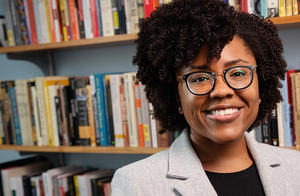It was an event that seemed to encapsulate the tumult of the 1960s. Police clashed violently with anti-war protesters in Chicago’s streets. Party factions waged political battle within the hall. What was happening in the 1968 Democratic Convention 50 years ago, and why? History professor Marsha Barrett specializes in modern U.S. political history, and her courses deal with the American political divide and the presidency. Barrett spoke with News Bureau social sciences editor Craig Chamberlain.
-
The clash in the streets gets many of the historical headlines, but what was significant about the political battles within the convention?
The Democratic Party was in a crisis in the summer of 1968 that was only exacerbated by the party’s divide over Democratic President Lyndon Johnson’s handling of the Vietnam War. Reform-minded Democrats had long criticized the party for being overly controlled by machine politics and party bosses. That critique only intensified in the 1960s as women, racial minorities, young voters and grassroots activists fought for representation in the party.
Representation became a major issue in the week before the convention when the credentials committee heard 15 challenges to the makeup of state delegations. The process by which the party chose its delegates was arcane, varied from state to state and was often determined in secret. While only two state delegations were successfully challenged and the nomination of Hubert Humphrey often seemed like a foregone conclusion, it started a process that led to the Democratic Party becoming more transparent and inclusive.
You make some comparisons between the Democratic Convention of ’68 and the contentious Republican Convention four years earlier. What’s the connection?
These conventions of the 1960s stand out as being unpredictable and dramatic in part because the rank-and-file of each party challenged the leadership in a way that caught the establishment by surprise. In 1964, the Republican Party establishment, centered in the Northeast, was essentially overwhelmed by the energy of conservatives who had been shunted to the sidelines for decades. That became evident not only with the nomination of Senator Barry Goldwater, but with a raucous show of support for Goldwater by convention attendees and delegates that was broadcast across the nation and made it difficult for the Republican Party to present itself as a united front celebrating its presidential ticket.
A lot of the unpredictability of these 1960s conventions was due to the increased involvement of activists and young people who believed that a convention should not be business as usual. For the Republicans, that meant a growing influence of more ideologically rigid conservatives who believed the national GOP had focused too much energy on appealing to the urban industrial populations and financial interests of the Northeast and on accommodating the expansive federal government ushered in by the New Deal.
For the Democrats in 1968, the energy of the party was largely with young people and a broader community animated by opposition to the Vietnam War and frustration that the anti-war candidates were to be left by the wayside. Young people were not the only people who fought for change in this period, but their enthusiasm, paired with the urgent efforts of the establishment in both parties to control the activist elements of their parties, led to dramatic clashes at the conventions. That soon became less common, in part because both parties began to institutionalize those elements.
Most conventions since then have been highly managed and relatively tame. The 2016 conventions were much less so. Do you see any political parallels between then and now?
As a historian, I resist overstating parallels between the present and the past, but there are some I see between the 1960s and the present. Both the Democratic and Republican Party conventions were more dramatic and less a strictly rehearsed affair because there were many people there who felt the party establishment either stifled real competition, in the case of the Democrats, or was unwilling to release the reins to an element of the party that identified more with the presumed nominee, in the case of the Republicans.
The 2016 conventions pale in comparison to the upheaval of the 1960s conventions, but they caught Americans off guard because we have become so accustomed to the highly produced conventions that appear to be more prepackaged pomp and circumstance for a predetermined outcome than an event that can chart a new path for a political party.
AUG 14, 2018 10:15 AM
Editor’s note: To reach Marsha Barrett, call 217-300-6679; email meb@illinois.edu; Twitter @MarshaEBarrett
